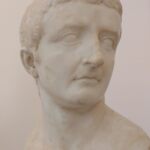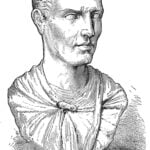Today we will talk about one of the most recognizable works of ancient European art – the so-called Laocoon Group. The sculpture, which is certainly one of the most valuable exhibits in the Vatican Museums, attracts the attention of everyone who stands in front of it. Baroque expressiveness makes it difficult to take your eyes off it. However, what makes it interesting is not only the heart-warming story set in stone, but also the number of secrets it hides.
But let’s start from the beginning. The sculpture depicts the Trojan priest Laocoön and his two sons. The story of Laocoön is a non-Homeric thread of the Trojan War, which cannot be found in the Iliad, but which we know thanks to Virgil’s Aeneid. Laocoon was supposed to warn the Trojans against accepting the Achaean gift in the form of the famous wooden (“Trojan”) horse in which Greek soldiers hid. Laocoon knew that nothing good could be expected from the Achaeans, but his warnings did not please the gods, whose will was for Troy to be conquered. To “silence” the overly clever priest, they sent two terrible snakes to kill him. Virgil leaves us a terrifying description of the scene that took place:
Through the still sea from Tenedos afar,
Lo, two great coiled snakes with much turning
First throw the flood towards the land in yearning.
(My spirit abhors this matter to declare)
Above the water their necks stand aware,
With bloody crests outwith the walls gigantic,
The remnant swam always under the flat pelagic
With grisly bodies linked many fold,
Thereshalt flame flourish from the rush they hold,
Into the ground they glided with glowing evening,
Stuffed full of venom, fire and foul teething,
With tongues flickering in their mouths red,
They like the twin killing stings in their head.
We fled away all bloodless for fear.
But with a braid to Laocoon to tear
They start attacking, and his two sons sing
First the other serpent latched on like a ring,
And with their cruel bite, and sting they fell,
Of tender limbs took many a sorry morsel;
Next they the priest invaded both to entwine,
Whence with his weapons did his body pine
His children for to help and rescue.
Both they about him looped in knots through,
And twice circled his middle round about,
And twice folded their scaly skin but doubt,
About his crown, both neck and head they scrag.– Aeneid
A sculpture in the Vatican Museums illustrates this dramatic moment, although the sculptors presented it slightly differently due to the specific requirements of the composition (more on this later). So we see Laocoön and his two sons in the moment immediately before their death. The younger son (on the left) is already painfully bitten and is dying. Look at him – he is very young, his slim and delicate body has not yet developed the masculine muscles that can be seen in his father and brother. The head of the snake biting into his side is barely visible because it is covered by the boy’s hand, trying with the last of his strength to tear the monster’s mouth from his body with his left hand. Efforts will be in vain: his pose indicates that he will soon fall to the ground helplessly.
Laocoön, located in the center of the composition, takes a particularly expressive pose. The left shoulder is pulled back, the right arm is bent and raised as if to throw away the snake’s body (unfortunately, this fragment of the sculpture has not survived). The head is tilted, the body is bent into an arch and the abdomen is pulled in spasmodically. Do an experiment – sit on a stool and try to adopt a pose like Laocoon. I checked and now I know that only terrible pain could force such a body system. If we look at Laocoön, we will see what is the source of his suffering: it is the snake biting into his left side that releases deadly venom into his veins.
Virgil writes that Laocoön screamed like a wounded bull, but the sculpture shows it differently. The marble Laocoön seems to stare silently at the sky. One theory is that carving a screaming face would make it “unmanly” and ugly, while the beauty of the sculpture was the highest goal of its creators. I don’t entirely agree with this theory. In my opinion, Laocoon’s pain is so great that he no longer has the strength to even scream. He knows that nothing will change God’s judgments.
The last figure is the older son, whom we see on the right and whose figure particularly appeals to our imagination. The two snakes had so far focused their attention on his younger brother and father. They haven’t caught my older son yet – so far they’ve only wrapped around one of his legs, which he’s desperately trying to free. He watches with horror the agony of his father and brother, knowing that the same thing will happen to him soon.
The younger son is already dying, the father is still fighting, and the older son will soon share their fate. Showing three characters attacked by snakes in such a different way gives the entire scene extraordinary dynamics.
The story of Laocoön and his sons may seem cruel to us, because in the Judeo-Christian tradition, penance is associated with sin, and punishment results from the offense. Meanwhile, ancient mythology presents us with a world in which man is only a helpless pawn on the divine chessboard. In this world, it depends only on the decisions of the gods on which pawns and pieces will be sacrificed. Even though he was innocent, Laocoön had to die so that the will of the gods could be fulfilled and Troy could fall.
This wonderful sculpture presents the whole situation somewhat differently than Virgil’s verses. In the poet’s story, the snakes attack first both of Laocoön’s sons and only then himself. If the sculpture had shown two sons being attacked, its meaning would have been much weaker – the presence of the father rushing to their rescue would have given a glimmer of hope. The presentation of the dying father and the younger son, as well as the older son helplessly watching this scene, deprives the viewer of any illusions – all three must die.
Another difference: in the Aeneid, snakes wrap a double ring around Laocoön’s chest and neck and strangle him. Showing the scene in this way would make the snake’s body completely cover the man’s torso, preventing the sculptors from emphasizing his tense muscles, and yet it is the musculature and unnatural position that add drama to the sculpture. Therefore, the sculptors decided to place the snakes in the lower part of the entire composition so that nothing would obscure the bodies of the dying Laocoön and his sons. For the same reason, all three are shown naked. They should have been dressed, because the snakes caught them while making sacrifices, but priestly clothes would have hidden everything that the sculptors wanted to emphasize and which is the source of the work’s expressiveness. So the sculptors had to omit the robes.
Sculpture is the source of many secrets. It was discovered at the beginning of the 16th century on the Oppius hill. Pliny the Elder writes that it stood in the house of the emperor Titus Flavius. On this basis, some conclude that the Flavian family home was on Oppius. Another theory says that when writing about the “domus of Titia”, Pliny actually had in mind part of the Gardens of Maecenas, which were located right next to it and which were part of the complex of imperial estates in Rome. If this were the case, we should probably assume that the sculpture came from Nero’s Golden House, of which the Maecenas Gardens were a fragment. This argument seems convincing in that neither Vespasian nor his son Titus were known for their particular extravagance, and placing such an unusual sculpture in their own home suits Nero much more than any other ruler of that era.
However, there is another competing theory that says that the house of Emperor Titus was located on the Quirinal Hill and that the sculpture originally stood there. It would have been transferred to Oppius by Trajan to decorate his magnificent baths built on the foundations of the Domus Aurea rooms. Unfortunately, it is not known what it really was like.
Another mystery is when the sculpture was created. Pliny the Elder gives the names of its creators (sculptors from Rhodes: Hagezander, Polydorus and Athenodorus), but does not mention when they lived, and other sources, unfortunately, do not contain any mention of them. Hence the problem with dating this masterpiece: there are different opinions on this matter. Some believe that the sculpture was created in the 2nd century BC, others say that it was commissioned by Augustus or someone from the imperial family. There is also a theory that it was actually commissioned as an illustration of the Aeneid by Virgil, who was a highly valued author by Augustus. Finally, there are those who believe that it is just a Roman copy of a Greek original that has not survived. Some secrets of the Laocoon Group will never be known. We can only admire the genius of ancient artists who were able to capture such a dramatic moment in cold stone.







